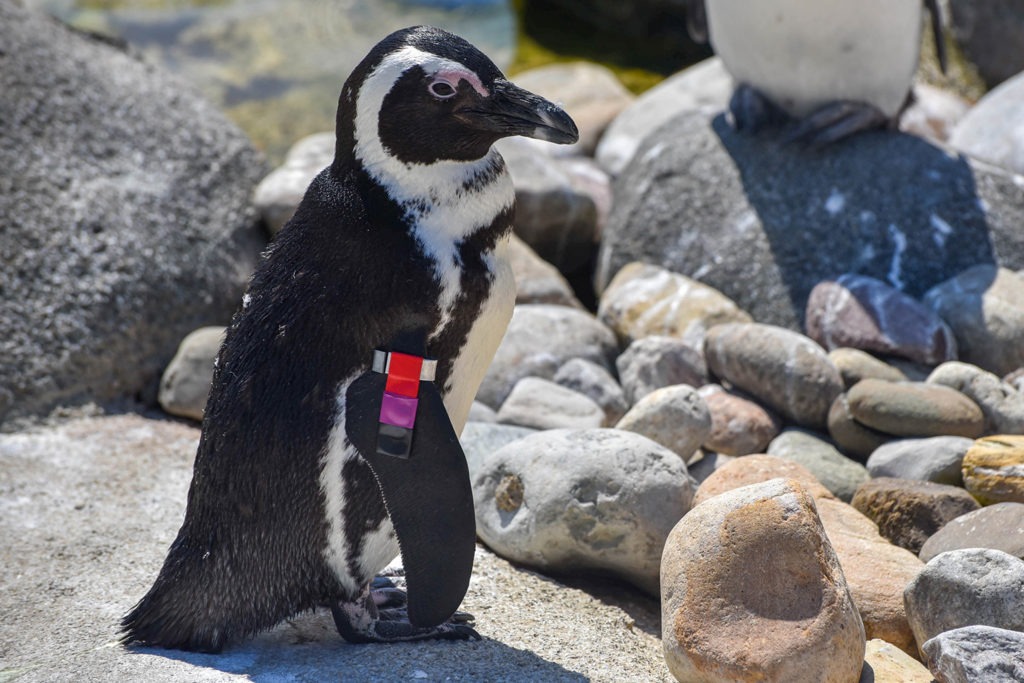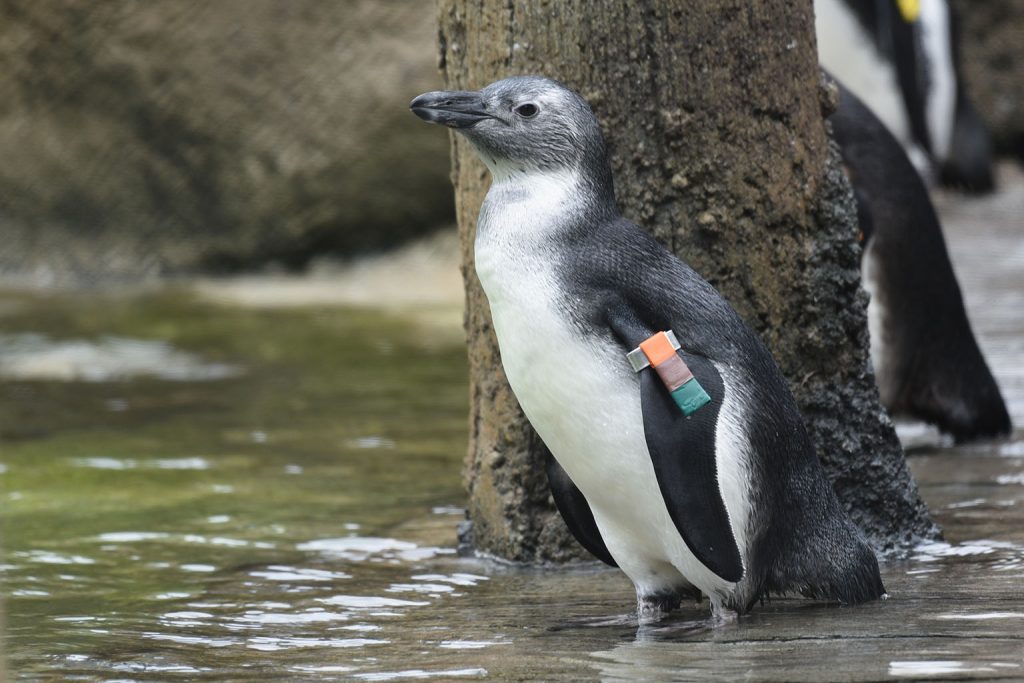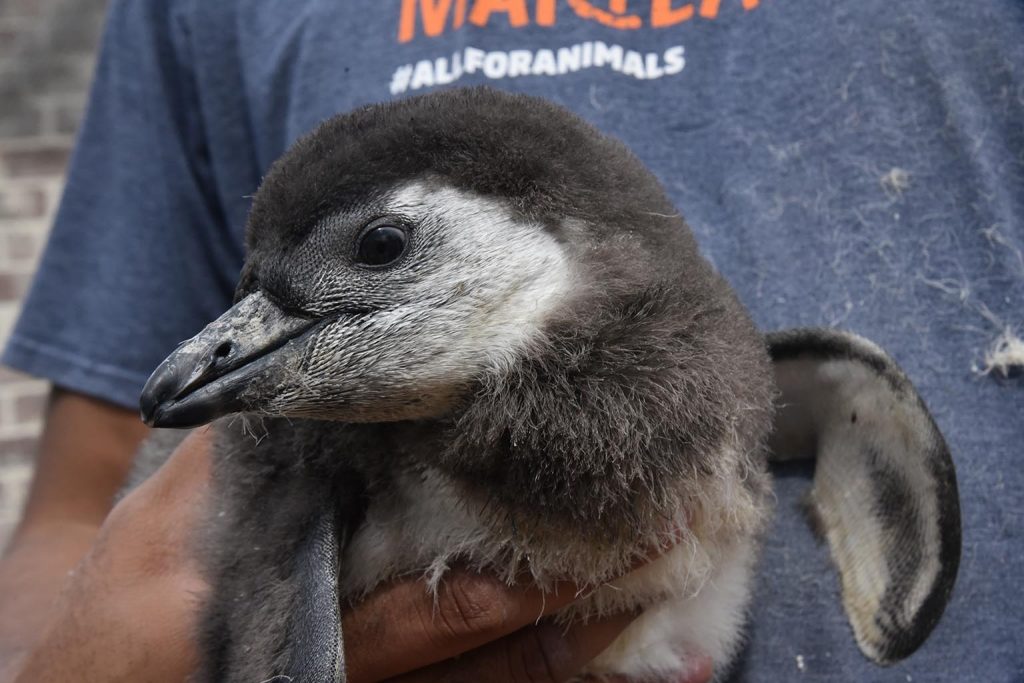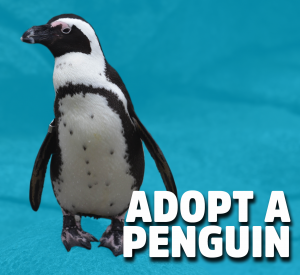Overview
“Where I live”
This species of penguin lives along the rocky coastline of southwest Africa, in the countries of South Africa and Namibia. It is found nowhere else in the world. Its range is restricted to a relatively small area where water temperature doesn’t fluctuate much. Like all penguin species, the African penguin lives in the Southern Hemisphere. It also lives in a temperate climate, as do most species of penguin. Only a few species live as far south as Antarctica in an extremely cold climate.
At The Maryland Zoo, African penguins can be seen at the new Penguin Coast exhibit in the African Journey exhibit. This species is also featured in the Zoo’s Animal Embassy collection as an Animal Ambassador.
“How I live there”
African penguins live in large colonies. They spend their days at sea feeding and their nights gathered together on shore. Like all penguins, African penguins are much more agile in water than on land. They are excellent swimmers with perfectly streamlined bodies. They can swim up to 12 mph.
They feed on small fish such as sardines and anchovies, as well as small crustaceans and squid. Each penguin eats about one pound of fish per day. They absorb water as well as nutrients from their diet, but also are adapted to drink salt water. All penguins have highly developed glands over their eyes that filter salts out of sea water.
“Making my mark”
Because penguins gather in such great numbers, the presence of any penguin colony is hard to miss. One colony of African penguins in particular, established at Boulders Beach near Cape Town, South Africa, has become something of a tourist attraction. People go there for the beach, the swimming, and to see the penguins.
“What eats me”
Sharks, Cape fur seals, and occasionally killer whales prey on African penguins. Mainland colonies also have to watch out for leopards, mongoose, genet, and domestic cats and dogs. Kelp gulls steal penguin eggs and newborn chicks. Despite protections in place for this species, people continue to collect African penguin eggs, although not to the extent that they once did. Penguin eggs have traditionally been considered a delicacy to eat, and for a very long time people also collected eggs for public and private egg collections. In the past, the birds were also food for sailors.
Raising Young
African penguins form monogamous pairs that stay together for about a decade, or for life, whichever comes first. Females construct nests out of guano (yes, bird poop!) because their rocky habitat offers little else in the way of nesting material. Each female lays two eggs per clutch, on average. Both male and female take turns incubating the eggs. Incubation lasts 38 to 42 days. Both parents also participate in caring for the chicks once they hatch.
Chicks are able to regulate their own body temperatures at 14 to 21 days. They then begin to form groups of chicks, or crèches, that are guarded by adults. Cooperative care allows individual sets of parents to go out to sea to feed. Both parents also feed the chicks at this time. Chicks fledge anywhere from 60 to 130 days.
Adult birds employ a few different strategies for keeping cool while stuck on shore molting, incubating eggs, or guarding newborn chicks. They stay in the shade as much as possible or stand with their white stomachs toward the sun in order to minimize heat absorption through their feathers and skin. They also cool off by opening their mouths and spreading their flippers (vestigial wings). Also, the hotter an African penguin gets, the more blood circulates to the pink glands above its eyes where air cools it.
Conservation
The African penguin is an endangered species whose population has declined by 90% since the turn of the 20th century. The current wild population is estimated at about 52,000 birds. Human interference of one sort or another has always posed the greatest threat to African penguins. Collecting eggs for sale and collecting guano for fertilizer (thus destroying nesting sites) nearly drove this species to extinction in the 20th century. Today, although better protected as a species, African penguins still must compete with commercial fishermen for access to fish.
- Learn about making penguin-friendly seafood choices from our conservation partner Monterey Bay Aquarium Seafood Watch.
They also remain vulnerable to pollution of their ocean habitat, particularly oil spills from big tankers. An enormous oil spill off the coast of South Africa in June 2000 impacted 19,000 adult African penguins at the height of their breeding season. Volunteers from The Maryland Zoo traveled to South Africa to help with the rescue and rehabilitation effort initiated by the International Fund for Animal Welfare and the South African Foundation for the Conservation of Coastal Birds. To date, this remains the largest animal rescue and recovery operation in history, with 91% of the affected birds rehabilitated and released successfully.
The Maryland Zoo maintains the largest colony of African penguins in North America and breeds the species at the recommendation of the AZA Species Survival Plan for African penguins. Since 1967, more than 1,000 African penguins have hatched at the Zoo.
Taxonomy
- Kingdom: Animalia
- Phylum: Chordata
- Subphylum: Vertebrata
- Class: Aves
- Order: Sphenisciformes
- Family: Spheniscidae
- Genera: Spheniscus
- Species: demersus
What is a Penguin Encounter?
At Penguin Coast, you can watch penguins waddle, swim, dive, and eat in North America’s largest African penguin colony. Want an even closer experience? Join us for a special Penguin Encounter! It’s your chance to meet and greet some of the Zoo’s endangered African penguins. Take part in an intimate, 20-30 minute tour with a guided keeper experience, special photo opportunities (think selfies), and up-close penguin interaction.





